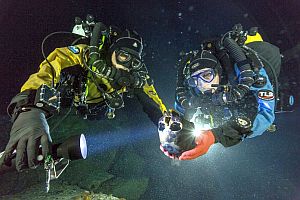In the waning days of the last Ice Age, a waifish teenage girl ventured into a Mexican cave. She would not emerge alive. In a dark passageway, she fell into a fathomless pit to a quick and brutal death.
Some 12,000 years passed before cave explorers discovered her remains in 2007 in Outland Cave in the Yucatán region of Mexico. Now scientists say her bones form one of the oldest and most complete human skeletons ever seen in the Americas, a unique find that's shedding light on a fierce debate about the first people to colonize the Americas. Genetic analysis shows the girl traces her ancestry to a vanished land that once stretched between Siberia and Alaska. That finding undercuts recent theories that the first people in the New World, called the Paleoamericans, originally hailed from southeastern Asia or Australia or even Europe.
The cave maiden gives scientists "opportunity to help answer the question of Paleoamerican origins," paleontologist James Chatters, an author of the analysis, told reporters this week. Her final resting place, "sealed off by water and darkness for more than 8,000 years, is a time capsule... of Central America at the end of the Ice Age."
The girl who entered the cave was 15 or 16, small and slight. She had decayed teeth and bones that bore signs of physical abuse. Fresh water was scarce in that age, so perhaps she sought the cave's pools. The fall into the pit broke her pelvis, and she died quickly if not instantly. Rising seas eventually submerged the cave.
The cave's stable temperatures helped preserve the bones, as did the neutral water that filled the cavern, Chatters says — a "lucky situation."
 |
In her facial structure, skull and teeth, Naia looks nothing like modern Native Americans. Neither do other Paleoamericans. That lack of resemblance has given rise to speculation that the earliest immigrants to the Americas came from far-flung places such as Polynesia or western Asia.
But an analysis of Naia's DNA shows her lineage began somewhere much closer: Beringia, the expanse of land that once connected Siberia and Alaska and now lies under the sea. Today's Native Americans also trace their roots to Beringia. So the first migrants to the New World and contemporary Native Americans are all the same family, researchers report in this week's Science. Whether they lived in the Americas 13,000 years ago or live there today, they can follow their heritage back in time to the same people, those who resided in Beringia more than 15,000 years ago.
Skeletons like Naia's are "scarcer than hen's teeth," says archaeologist Michael Waters of Texas A&M University, who studies the first Americans. The new analysis, he says, provides further evidence that the first people to settle the New World "gave rise to modern people."
As a result of the new study, the "problem" of the different features of the Paleoamericans vs. modern-day Native Americans "has now been resolved," says geneticist Rasmus Nielsen of the University of California, Berkeley. "Of course, it's interesting, because it raises a new question: Why are there skull and facial changes? Is it really true that Native Americans have evolved... in such a short amount of time?"
Chatters points out that other human populations have evolved over short time periods. His team's next step is a more thorough genetic analysis of Naia, whose bones have more stories to tell.
Original Story


